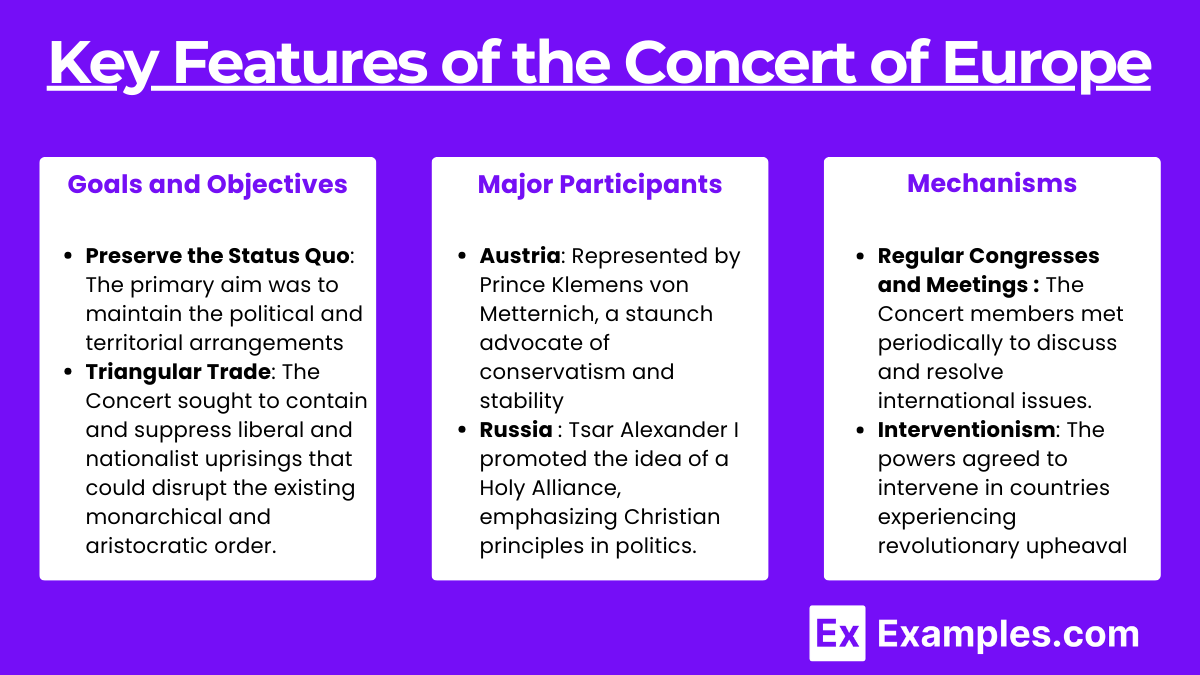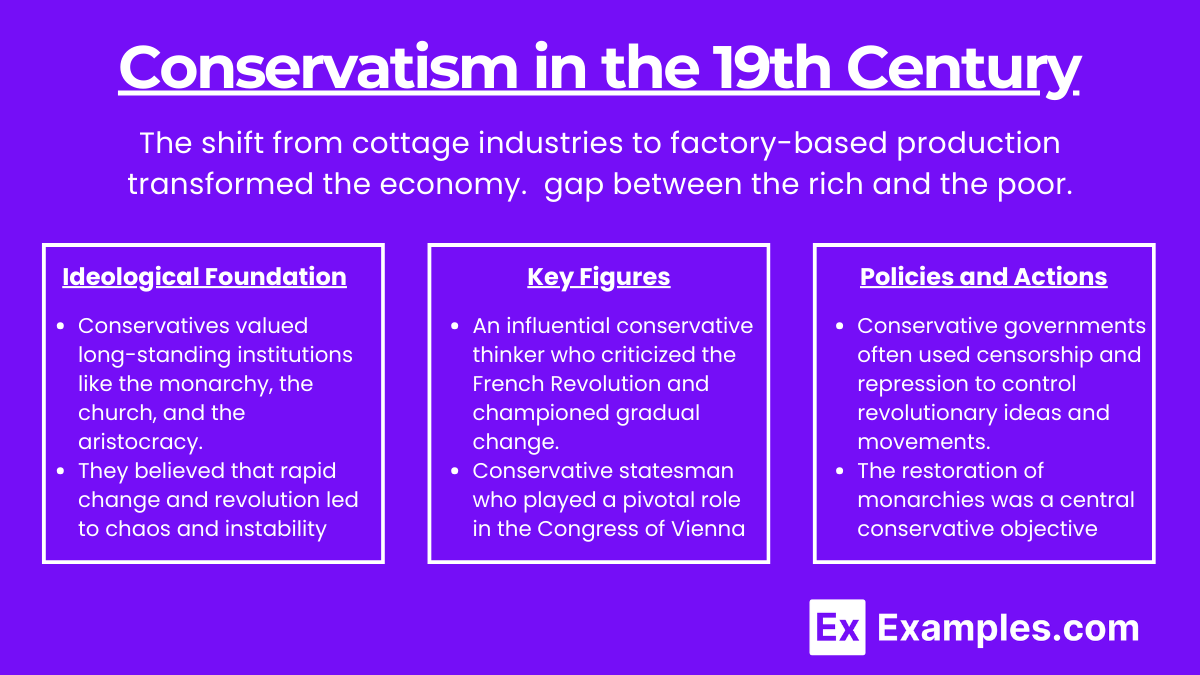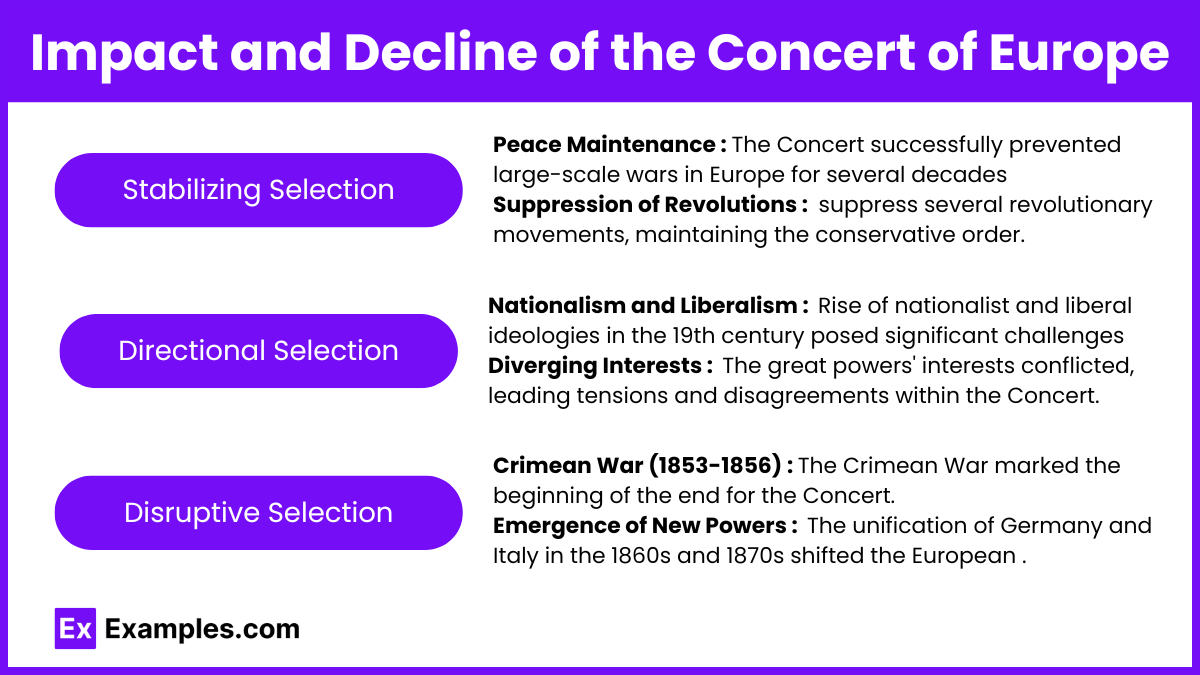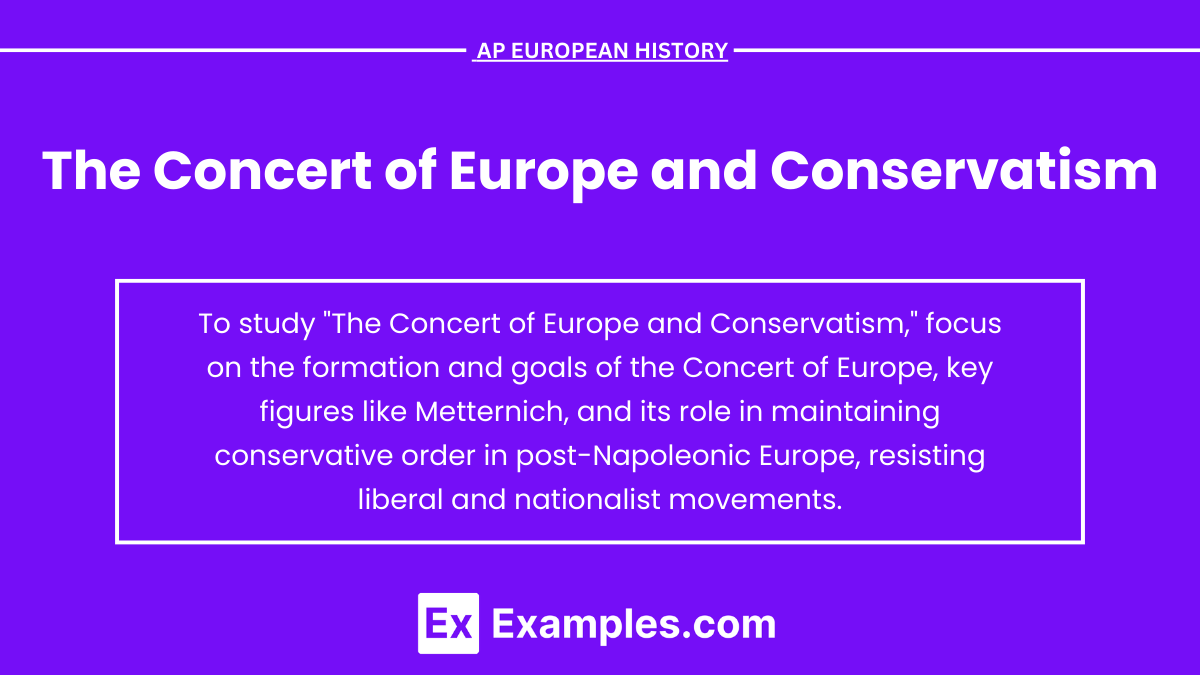The Concert of Europe was a diplomatic system established after the Napoleonic Wars to maintain stability and balance of power in Europe. It was closely linked with conservatism, an ideology that sought to preserve traditional institutions and resist revolutionary changes. Together, these forces aimed to suppress nationalist and liberal movements, uphold monarchies, and prevent conflicts. This system, characterized by cooperation among major powers like Austria, Russia, Prussia, and Britain, played a crucial role in shaping 19th-century European politics and maintaining peace for several decades.
Learning Objectives
By studying “The Concert of Europe and Conservatism” for the AP European History exam, you should understand the principles and mechanisms of the Concert of Europe, the goals and actions of key conservative figures, and the ways in which conservatism sought to maintain the status quo. You should also learn about significant congresses, the successes and limitations of the Concert system, and how rising nationalism and liberalism eventually challenged and weakened these conservative efforts, setting the stage for future European conflicts and transformations.
The Concert of Europe
The Concert of Europe was a diplomatic system developed after the fall of Napoleon Bonaparte, aiming to maintain the balance of power in Europe and prevent the resurgence of widespread conflict. It emerged from the Congress of Vienna (1814-1815), where major European powers—Austria, Russia, Prussia, and Great Britain—sought to establish a new order in Europe.
Key Features of the Concert of Europe

1. Goals and Objectives:
- Preserve the Status Quo: The primary aim was to maintain the political and territorial arrangements established by the Congress of Vienna.
- Suppress Revolutionary Movements: The Concert sought to contain and suppress liberal and nationalist uprisings that could disrupt the existing monarchical and aristocratic order.
2. Major Participants:
- Austria: Represented by Prince Klemens von Metternich, a staunch advocate of conservatism and stability.
- Prussia: Led by King Frederick William III, Prussia aimed to solidify its influence in German-speaking regions.
- Russia: Tsar Alexander I promoted the idea of a Holy Alliance, emphasizing Christian principles in politics.
- United Kingdom: Focused on maintaining a balance of power and preventing any single state from dominating Europe.
3. Mechanisms:
- Regular Congresses and Meetings: The Concert members met periodically to discuss and resolve international issues.
- Interventionism: The powers agreed to intervene in countries experiencing revolutionary upheaval, as seen in the suppression of the Italian revolts (1820-1821) and the Spanish uprising (1823).
Conservatism in the 19th Century

Conservatism was a dominant political ideology during the 19th century, particularly after the defeat of Napoleon. It was characterized by a desire to preserve traditional institutions, social hierarchies, and the existing political order.
1. Ideological Foundation:
- Emphasis on Tradition and Stability: Conservatives valued long-standing institutions like the monarchy, the church, and the aristocracy.
- Skepticism of Change: They believed that rapid change and revolution led to chaos and instability, as evidenced by the French Revolution.
2. Key Figures:
- Edmund Burke: An influential conservative thinker who criticized the French Revolution and championed gradual change.
- Prince Klemens von Metternich: A leading conservative statesman who played a pivotal role in the Congress of Vienna and the Concert of Europe.
3. Policies and Actions:
- Censorship and Repression: Conservative governments often used censorship and repression to control revolutionary ideas and movements.
- Restoration of Monarchies: After the defeat of Napoleon, the restoration of monarchies was a central conservative objective, reinstating traditional rulers and boundaries.
Impact and Decline of the Concert of Europe

1. Successes:
- Peace Maintenance: The Concert successfully prevented large-scale wars in Europe for several decades.
- Suppression of Revolutions: It managed to suppress several revolutionary movements, maintaining the conservative order.
2. Limitations and Challenges:
- Nationalism and Liberalism: The rise of nationalist and liberal ideologies in the 19th century posed significant challenges to the conservative framework.
- Diverging Interests: The great powers’ interests often conflicted, leading to tensions and disagreements within the Concert.
3. Decline:
- Crimean War (1853-1856): The Crimean War marked the beginning of the end for the Concert, as it pitted major powers against each other.
- Emergence of New Powers: The unification of Germany and Italy in the 1860s and 1870s shifted the European balance of power, diminishing the Concert’s influence.
The Concert of Europe was a key conservative response to the revolutionary upheavals of the late 18th and early 19th centuries. While it succeeded in maintaining peace and suppressing revolutions for a time, it ultimately faltered in the face of rising nationalism and liberalism. Understanding the Concert’s structure, goals, and eventual decline is crucial for mastering this aspect of European history and achieving success on the AP European History Exam.
Examples
Example 1
The Congress of Vienna (1814-1815) : The Congress of Vienna was a meeting of European powers that aimed to restore pre-Napoleonic order and balance of power. It established the Concert of Europe, a system designed to prevent the outbreak of widespread conflict and maintain stability across the continent.
Example 2
The Holy Alliance (1815) : Formed by Russia, Austria, and Prussia, the Holy Alliance was a conservative coalition that aimed to uphold Christian values and the status quo. It played a significant role in suppressing revolutionary movements and promoting conservative monarchies.
Example 3
The Quadruple Alliance (1815) : Comprising the United Kingdom, Austria, Prussia, and Russia, the Quadruple Alliance was created to enforce the decisions made at the Congress of Vienna. It was instrumental in maintaining peace and addressing potential threats to the European balance of power, including liberal and nationalist uprisings.
Example 4
The Carlsbad Decrees (1819) : Issued by the German Confederation, under the influence of Metternich, the Carlsbad Decrees aimed to curb liberal and nationalist movements in the German states. These decrees were a clear manifestation of conservative efforts to suppress ideas that challenged the established order.
Example 5
The Greek War of Independence (1821-1829) : While the Concert of Europe generally opposed revolutionary movements, the Greek War of Independence was a notable exception. The major European powers, including Britain, France, and Russia, intervened in support of Greek independence from the Ottoman Empire, partly influenced by a mix of humanitarian concerns and strategic interests. However, this intervention was still guided by the conservative goal of maintaining stability in Europe.
Multiple Choice Questions
Question 1: Which of the following best describes the primary goal of the Concert of Europe?
A) To promote democratic reforms across Europe
B) To maintain the balance of power and prevent major conflicts
C) To support revolutionary movements in colonies
D) To encourage economic competition among European nations
Answer: B) To maintain the balance of power and prevent major conflicts
Explanation:
The Concert of Europe was an alliance formed after the Congress of Vienna in 1815, consisting of the major European powers: Austria, Russia, Prussia, and the United Kingdom. Its primary goal was to maintain the balance of power in Europe and prevent the outbreak of major conflicts that could destabilize the continent. This system aimed to preserve the status quo and prevent any single country from becoming too powerful.
Question 2: Conservatism in the early 19th century, as exemplified by leaders like Prince Metternich, emphasized which of the following principles?
A) Universal suffrage and equality
B) Preservation of traditional social hierarchies
C) Nationalism and self-determination
D) Free trade and economic liberalism
Answer: B) Preservation of traditional social hierarchies
Explanation:
Conservatism during the early 19th century, particularly under leaders like Austrian Chancellor Prince Klemens von Metternich, was focused on preserving the existing social and political order. This included maintaining traditional hierarchies and institutions, such as monarchies and aristocracies, and opposing the spread of revolutionary and liberal ideas that threatened these structures. Conservatism sought to uphold stability and continuity, often resisting changes that could lead to social upheaval.
Question 3: Which event demonstrated the limitations of the Concert of Europe in preventing nationalist and liberal uprisings?
A) The Crimean War
B) The Revolutions of 1848
C) The Napoleonic Wars
D) The Franco-Prussian War
Answer: B) The Revolutions of 1848
Explanation:
The Revolutions of 1848 were a series of interconnected revolutionary movements across Europe, characterized by demands for liberal reforms, national independence, and social changes. These uprisings highlighted the limitations of the Concert of Europe in managing and suppressing nationalist and liberal sentiments. While the Concert of Europe aimed to preserve the old order and prevent such upheavals, the widespread nature and intensity of the revolutions showed that the forces of change could not be easily contained or managed through diplomatic means alone.


